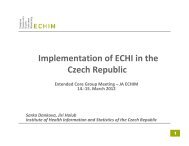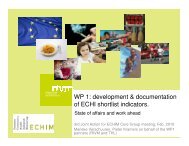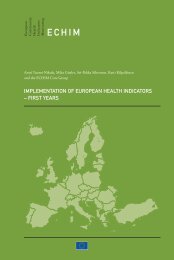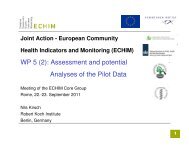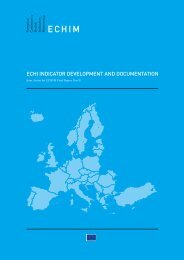INDICATORS
ECHIM Final Report
ECHIM Final Report
Create successful ePaper yourself
Turn your PDF publications into a flip-book with our unique Google optimized e-Paper software.
Calculation: Indicator needs further development.<br />
OECD, “waiting times of the patients admitted”: The time elapsed for a patient on the<br />
elective surgery waiting list from the date they were added to the waiting list to the date<br />
they were admitted to an inpatient or day-case surgical unit for the procedure (PTCA, hip<br />
replacement, cataract operation). Both mean and median times in days.<br />
Notes: The three procedures were selected as examples from the best for data availability at<br />
OECD, and as being similar to the ones measured under the indicator 73. Surgeries: PTCA,<br />
hip, cataract.<br />
Concepts of “waiting times of the patients admitted” versus “waiting times of the patients on<br />
the list at a census date”.<br />
82. SURGICAL WOUND INFECTIONS<br />
Definition: Surgical wound infection rate, as % of all surgical operations.<br />
Calculation: Indicator needs development.<br />
1) WHO: Average rate (in all hospitals) of inpatient surgical operations with postoperative<br />
surgical wound infection (i.e. with code for postoperative wound infections, ICD-9: 998.5<br />
and ICD-10: T81.4) during the given calendar year, expressed as percentage of all surgical<br />
operations.<br />
2) Safety Improvement for Patients in Europe, SImPatIE recommendation: Percent of<br />
patients experiencing a wound infection (ICD-9 998.51 and 998.52; secondary diagnosis<br />
only) out of all hospitalised patients. (Indicator PSI 11: Wound Infection)<br />
Notes: Indicator for the safety of operative interventions. Wound infection can lead to reoperation<br />
and prolonged hospital stay, to increased morbidity and mortality for patients and<br />
to increased costs for the health care system. Amenable to interventions: the incidence of<br />
wound infection can be reduced by proper pre-, intra- and post-operative care, in particular<br />
strict hygiene.<br />
83. CANCER TREATMENT DELAY<br />
Definition: Cancer treatment delay is defined as the average time (in days) between the<br />
date of first visit to general practitioner and the date of first treatment, by cancer site (breast,<br />
colon and rectal cancer).<br />
Calculation: No calculation procedure yet, indicator being developed. EUROCHIP: Cancer<br />
treatment delay is calculated as the difference (in days) between “date of first visit to general<br />
practitioner” and “date of first treatment”.<br />
Notes: For each cancer patient, five (six) dates in his/her patient history can be distinguished:<br />
1) First visit to general practitioner, 2) First request for a clinical/hospital appointment, 3)<br />
First clinical/hospital appointment, 4) Date of definitive diagnosis, 5) Date of first treatment<br />
(surgery, systemic therapy or radiotherapy), And for colon and rectal cancers, also 6)<br />
Information on elective or emergency surgery.<br />
133




